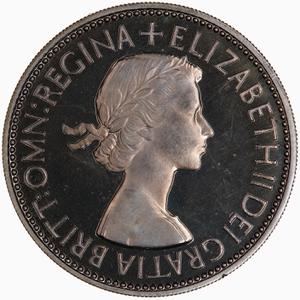Information about effigy: Queen Elizabeth II - First Portrait, by Mary Gillick

The first definitive effigy of Queen Elizabeth II was designed by Mary Gillick, and shows the wreathed head of the Queen facing right. Mary Gillick was a sculptor best known for her effigy of Elizabeth II used on coinage in the United Kingdom and elsewhere from 1953 to 1970. In 1952, Gillick's effigy design was selected from a field of seventeen to be used on general-circulation coinage for the new Queen Elizabeth, first issued in 1953. According to the Royal Mint "The portrait was fresh, evocative and beautifully reflected the optimistic mood of the nation as it greeted a new Elizabethan era. It was designed by Mary Gillick and shows The Queen wearing a wreath." Gillick's design was notable for portraying the Queen uncrowned, and was the last to be used on the pre-decimal coinage. In keeping with tradition, all Maundy money and various commemorative issues continued to use this first official effigy of Her Majesty even after other effigies were adopted for regular coins. Gillick's die master had insufficient relief, and the striking was too weak. Facial features and the dress folds in the shoulder disappeared. The problem was solved by re-cutting the dies. This remastering was performed by Cecil Thomas, an experienced medalist who had already crafted overseas currencies featuring Elizabeth II, but who had initially been turned down for the British coinage in preference to Gillick. In most countries, the switch happened between years, so the coins of one year had the old die and those of the next year the new one; however, in New Zealand for example, it happened mid-year creating "no shoulder strap" varieties. As a matter of pedantic interest, it has to be said that the so-called "shoulder strap" is not, in actual fact, a strap but a fold in Her Majesty's gown. A cameo of Gillick's effigy of the Queen has also been used on British commemorative stamps since 1966. The effigy was used on both United Kingdom coinage and the coinage of many Commonwealth countries until Arnold Machin’s portrait of Queen Elizabeth II was adopted. The exception is Maundy Money. All Maundy pieces continue to use the original obverse design for Queen Elizabeth II by Mary Gillick, although the bust of the Queen on other British coins has been repeatedly replaced as she ages. At the time of decimalisation, the Royal Mint Advisory Commission recommended the retention out of affection for the Gillick design; this was accepted by the Queen. |

First master die ("No shoulder strap"), copper-nickel proof United Kingdom / Two Shillings (Florin) 1953 The lack of relief of the master die can be seen on this Cupro-Nickel proof coin of 1953, which was one of the earliest strikes of the new obverse design on coinage of the United Kingdom. |
|
| Year | 1953 |
|---|---|
| Personal Information | Queen Elizabeth II |
| Image | Details |
|---|---|

|
Proof Coin - Florin, Elizabeth II, Great Britain, 1953
Copyright: Museum Victoria / CC BY Author: Justine Philip Notes: First master die ("No shoulder strap"). Cupro-Nickel (Proof). Source |

|
Proof Coin - 1 Penny, New Zealand, 1953
Copyright: Museum Victoria / CC BY Author: Heath Warwick Notes: First master die. Bronze (Proof). Source |

|
Proof Coin - 50 Cents, Canada
Copyright: Museum Victoria / CC BY Author: Jennifer McNair Notes: Re-cut master die. Silver (Proof). Source |

|
Coin - 1 Penny, New Zealand, 1956
Copyright: Museum Victoria / CC BY Author: Jennifer McNair Notes: Re-cut master die. Bronze. Source |

